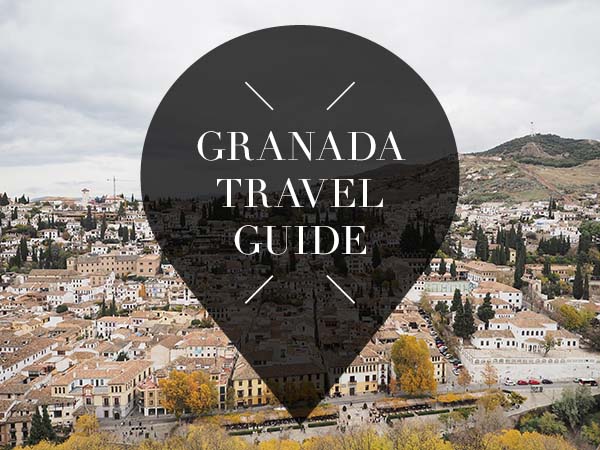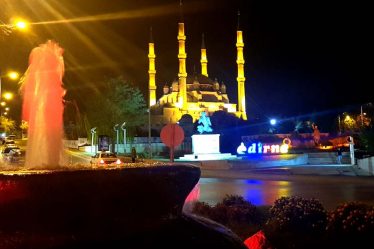
Granada isthe capital of the province of the same name in southern Spain , at the foot of the Sierra Nevada Mountains. The city, where its traditional cultural structure is preserved, stands out with its magnificent natural beauties and vibrant nightlife.
The Alhambra Palace, which is considered to be one of the most magnificent structures that has survived from the Andalusian Umayyad State, is the most popular tourist spot in Granada. While there are many historical buildings representing the Umayyad culture in the city, lively squares, narrow streets and pleasant cafes are reasons enough to explore the streets of the city on foot.

Granada, located in the southeast of Spain, is one of the cities where the Andalusian culture is dominant. The city, which was the capital of the Kingdom of Granada for many years, is located at the foot of the Sierra Nevada Mountains, on the banks of the Genil River. Granada, Spain’s 5th largest city with an area of approximately 13 thousand square kilometers, is 360 kilometers from the capital Madrid.
The city, which was first an Iberian settlement, remained under the rule of the Moors for centuries. Known as the Damascus of the West because of its ever-growing growth, Granada became the last stronghold of the Moors. The city, which draws attention with its palaces, cathedral, mosque, church and other structures from the Moors, is among the most touristic cities of Spain today.
Places to Visit in Granada
Granada is known as the city where cultures meet in Spain. Although it has a very small area, it is possible to come across pieces of many cultures that have left their mark on the history of the region. Granada’s neighboring districts, Sacromonte and Albaicin, are also part of the multicultural structure.
Standing out with its architectural wonder Christian monastery, Sacromonte is the right address to see how gypsies live in cave houses and to watch flamenco and zambra dances.
Albaicin, the Arabian Square, is home to a century-old spice bazaar. Colorful carpets and exotic teas and the scent of spices reflect the atmosphere of the market.
Places to Visit in Granada
- Alhambra Palace
- Generalife Palace
- Patio of the Lions
- Albaicin
- Capilla Real de Granada
- Catedral Santa Maria de la Encarnacion
- Gypsy Quarter, Sacromonte
- La Alcaiceria
- Basilica de las Angustias de Granada
- Casa de Zafra
- The Madrasa of Granada
- De la Cartuja
- Monastery of St. Jeronimo
- Hammam Al Andalus
1. Alhambra Palace

The Alhambra Palace (Alhambra) is undoubtedly the most famous structure in Granada. The Alhambra Palace (Alhambra), which is the most important place among the places to visit in Granada, stands in all its glory on a hill with the magnificent view of the Sierra Nevada Mountains behind it. The palace, which is also on the UNESCO World Heritage List, is the first stop for visitors to Granada, and they are not wrong about it.
The palace, whose foundation was laid in 1238 during the reign of Muhammad I, who founded the Beni Ahmer state, was the place where Moorish rulers lived. For 250 years, from the 13th to the 15th centuries, it was a living museum of Islamic architecture. It was gradually expanded by people from the same family.
Alhambra, Palace, The Alhambra, surrounded by ancient walls, resembles an inaccessible castle when viewed from afar. This castle was the last Moorish stronghold in Spain. The palace, which takes its name from the word hamra , meaning red in Arabic, because it is made of red bricks, and the palace, which consists of interconnected buildings, has magnificent courtyards, gardens and fountains. The Alhambra, which is decorated with verses of the Qur’an and Arabic poems, is visited by millions of visitors every year. The palace, which is shown as one of the most beautiful examples of Islamic architecture, has been on the UNESCO World Heritage List since 1984 .
The Alhambra consists of four groups of carefully constructed buildings. The original 13th-century Moorish fortress, Alhazaba, is the oldest part of the Alhambra. Today, only the walls and towers remain from the original Alkazaba. Nasrid palaces are the most magnificent structures. Make sure to buy your ticket weeks in advance from the internet or at the sales points in Granada.
2. Generalife Palace

The Generalife Palace is one of the most touristic places in Granada. Originally named Jannat al-‘Arīf, meaning ‘The Architect’s Garden’ in Arabic, the building is known as Generalife in English. The palace, which was built between 1302 and 1309 by the Emir of Granada, Mohammed III, was redecorated by the next Emir, Ismail I. Generalife, which was originally built in direct connection to the Alhambra Palace, is separated from the Alhambra today due to a valley formed by erosion. Generalife attracts tourists with its Patio de la Acequia (Waterway Garden), which consists of a long pool decorated with flowers and fountains, and the Jardím de la Sultana, one of the most preserved gardens in the history of Andalusia.
3. Patio of the Lions

Patio of the Lions , a complex of palaces , is located approximately 450 meters from the Alhambra Palace. Built between 1362-1391 by the Emir of Granada, Sultan Mohammed V, the palace rises above 124 columns. Although it has an Islamic style, the building, which draws attention with its animal-figured fountain, is among the structures that attract the most visitors in Granada.
4. Albaicin

Albaicin (Albayzin), the oldest district of Granada , is located on a hill overlooking the Alhambra Palace. Dividing the city in two before meeting with the Genil River, the Darro River separates the Albaicin District from the Antequeruela District in the south. Attracting attention with its narrow white streets, white shops and shops belonging to Arab vendors, Albaicin is now home to the Roma. Albaicin was surrounded by large defensive walls built against the enemies in the past. Where the walls look most beautiful is the 9th-century Cuesta de la Alhacaba, once the main gate of the city. Many places in the Albaicin have incredibly beautiful views of the Alhambra Palace.
If you want to have a fascinating experience, try getting lost in the streets of Albaicin, a UNESCO World Heritage Site. This historic Arab quarter is located on the outskirts of Sacromonte. Narrow streets and white houses highlight the characteristic features of the Moorish atmosphere.
5. Capilla Real de Granada

Capilla Real de Granada (Royal Chapel of Granada) is a religious building with royal tombs reflecting the splendor and power of Spain’s Catholic Monarchs. Looking quite impressive, the 47-metre high domed chapel connects to the Catedral Santa María de la Encarnación, but has a separate entrance.
The interior of the chapel is home to wonderful 16th-century stained glass windows and seven large paintings by Alonso Cano. The sarcophagi in the chapel contain the bodies of many kings and princesses. In the large, carved section behind the royal tombs you can see statues of Catholic monarchs by Diego de Siloé.
6. Catedral Santa Maria de la Encarnacion

Located in the historic center of Granada, the Cathedral of Granada (Catedral de Granada) is considered the best Renaissance church in Spain. The cathedral was built by Queen Isabella in 1561 as a memorial to the Christian victory over the Moors. It was designed in Gothic by Enrique de Egas, inspired by Italian architects. With its Corinthian columns, magnificent stained glass and splendid design, the cathedral took 181 years to complete. Visited by thousands of people every year, Granada Cathedral holds the title of Spain’s second largest cathedral.
On the west side of the cathedral, which is a work of the 16th century, there is a large relief made by José Risueño, just above the main door. The northwest side of the cathedral is filled with ornate statues. The statues on the arch columns at the entrance are bronze statues of Catholic monarchs. The museum section of the cathedral is also very rich.
7. Gypsy Quarter, Sacromonte

Known as the birthplace of flamenco, Granada’s colorful Gypsy neighborhood Sacromonte is both a fascinating and exotic place to visit. The Gypsies (Gitanos) were part of Granada since 1532 and settled in the caves of Sacromonte in the 18th century. There are many caves that are still used by gypsy families and have adapted very successfully to the 21st century. The caves at the top of the Camino del Sacromonte are the best. The flamenco tradition continues to be well preserved by the Gypsies of Granada.
Sacromonte, one of the most mystical areas of Granada, is located on the east side of the city. The area is located on the Valparaíso Valley, with views of the Alhambra and the Darro River. Some houses in the neighborhood also have very lively, colorful handmade ceramics.
8. La Alcaiceria

La Alcaiceria (Arab market) is the embodiment of the former Moorish market, which was in the area completely destroyed by the fire in 1843. Resembling a maze of narrow streets, Alcaiceria’s neighborhoods were once a large place that controlled the silk and spice market.
Today’s Alcaiceria, on the other hand, resembles a replica of its original state, with many artistic and souvenir stalls. Another highlight near the market is Plaza Bib Rambla, a very large public square where people throng and events take place.
9. Basilica de las Angustias de Granada
The Basilica de las Angustias de Granada is one of the city’s holiest sites. The basilica, whose construction began in 1617 under the supervision of Juan Luis Ortega, is approximately 3 km from the Alhambra Palace. This holy building, which contains the works of Granada’s Baroque artists, is among the must-see places in Granada.
10. Casa de Zafra
Casa de Zafra , one of the most famous buildings in Granada , is located in the heart of Albaicin, an old residential area. Built in the 14th century by Hernando de Zafra, a member of one of the important royal families, the house was designed in Arabic architecture. Casa de Zafra, which also houses a monastery called El Convento de Santa Catalina de Siena, was declared a legal protected area in 1985. The building, which was restored and renovated between 2010-2012, is considered one of the most important touristic centers of the city today.
11. The Madrasa of Granada
The Madrasa of Granada ( Madraza de Granada ) was founded in 1349 by the Nasrid Sultan of Granada, Yusuf I. The building, which is used both as a madrasah and a mosque, is located on the street known as Calle Oficios. The building of the madrasah, where important Arab scholars such as Ibn-i Feccar, Ibn Marzuq, and Ibn-i Hayy taught, is used by the University of Granada today.
12. De la Cartuja

The 16th century De La Cartuja Monastery is located on the outskirts of Granada, with a very peaceful atmosphere. Cartuja Monastery, also known as the Monasterio de la Nuestra Señora de la Asunción (Carthusian Monastery), belonged to the Carthusian government founded in France in the 11th century. There is a simple exterior and a surprisingly luxurious interior behind the courtyard.
The monastery’s 17th-century Baroque sanctuary, magnificent paintings, marble statues, gilded designs and impressive altars manage to enchant visitors. The most striking feature of the church is that it is a holy place designed by Luis de Arévalo, filled with peaceful wall designs and marble columns.
13. Monastery of St. Jeronimo
The Monastery of St. Jeronimo (Monasterio de San Jerónimo) is known as the first monastery that Christians built after conquering the city. The palace, whose construction began in 1496, has the style of Spanish Baroque architecture. The St. Jeronimo Monastery, which attracts attention with its magnificent design, can be entered for 4 Euros.
14. Hammam Al Andalus

The Moors carried the bath culture (Arab Baths) from their homeland in North Africa to Andalusia. Visitors to Granada can experience the Andalusian hammam tradition. Al Andalus (Andalusian) Baths appear as authentic Arab Baths with a Moorish style.
Located on the ruins of an old bath at the foot of the Alhambra, the complex was completely renovated and opened to the public. The baths, which have been restored to their former glory, stand out with their traditional Islamic style elegant arches and elegant tile designs. There are three swimming pools in Hamam.
Granada , the magnificent city of Andalusia , is among the most touristic places in Spain with its unique religious buildings, gardens, palaces and other beauties.


